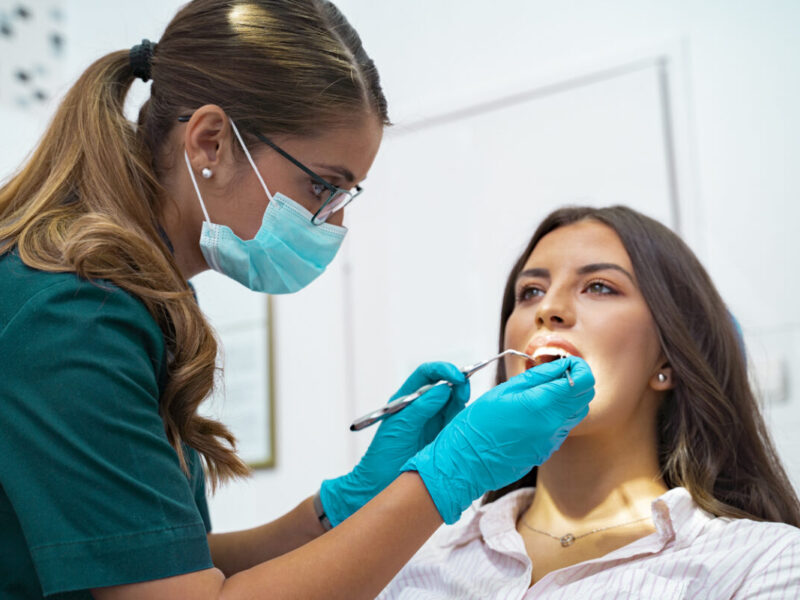A Guide to Splinting Teeth After Dental Trauma
Facing dental trauma can be a worrying time, but knowing how to care for your teeth afterwards can ease a lot of that concern. Splinting teeth after dental trauma is a key step towards healing, offering support to teeth that need it most. In this guide, we’ll walk you through what splinting involves, its benefits, and how it aids in the recovery process. We aim to provide you with the knowledge and confidence to handle dental injuries effectively.

A Quick Look at Dental Trauma
Dental trauma refers to any injury to the teeth, gums, or mouth area, often resulting from accidents or sports mishaps. It ranges from a minor chip or crack in a tooth to more severe cases like knocked-out teeth or injury to the jaw. Common causes include falls, impacts during sports, vehicle accidents, or even biting down on hard food. Immediate attention is crucial to prevent long-term damage and ensure the best possible outcome for your dental health. Understanding these incidents can help in taking quick and effective steps towards recovery. Ensure you seek help from an emergency dentist Brisbane in case of dental injuries.
What Does Splinting Teeth Mean?
Splinting teeth is like putting a cast on a broken arm but for your teeth. When teeth get loose or injured, a dentist uses a splint—a small, stabilizing support—to hold them together. This keeps the teeth in place, just like friends holding hands, allowing them to heal properly after an injury. It’s a simple yet effective way to ensure your teeth recover correctly, staying aligned and secure while the surrounding tissues mend.
Process of Splinting Teeth After Dental Trauma
The process of splinting teeth after dental trauma involves several careful steps to ensure injured teeth are stabilized and set on the right path to healing. Here’s a simplified overview and what patients can expect:
Assessment: The Brisbane dentist first examines the injured area to understand the extent of the trauma. This might include X-rays to see beyond what’s visible to the naked eye.
Cleaning: The affected area is gently cleaned to remove any debris or bacteria, reducing the risk of infection and preparing the teeth for splinting.
Selection of Splint Type: Depending on the injury’s severity and the specific teeth involved, the dentist chooses the most suitable type of splint, whether it be flexible, rigid, or another kind.
Application: The chosen splint is carefully applied. For example, if using a bonded composite splint, the dentist will bond the injured tooth to its neighbours using a special dental adhesive. This process is usually pain-free, though there might be some discomfort depending on the injury’s severity and the patient’s overall dental health.
Setting and Curing: The splint is then set in place, often using a curing light if composite materials are involved. This hardens the adhesive quickly and secures the splint.
Instructions for Care: Patients receive guidance on how to care for their splinted teeth, including dietary recommendations, cleaning instructions, and signs of potential complications to watch for.
Follow-Up: Follow-up appointments are scheduled to monitor healing, adjust the splint if necessary, and eventually remove the splint when the teeth have stabilized.
Throughout the procedure, comfort measures are taken to ensure the patient remains at ease. The goal is to make the experience as stress-free as possible, guiding patients towards recovery with professional care and support.
Benefits of Splinting Teeth After Trauma
Splinting teeth after trauma helps ensure that injured teeth heal properly and stay in place. This method significantly boosts the recovery process, making it smoother and more effective for patients.
Faster Healing Process
By stabilizing the teeth, splinting creates an ideal environment for natural healing. It allows the bone and tissues around the injured teeth to mend more quickly and correctly.
Reduced Discomfort
Splinting limits the movement of injured teeth, significantly reducing pain and discomfort during the healing phase. Patients find it easier to manage daily activities without the added stress of tender teeth.
Improved Function
With the teeth securely splinted, patients can speak and eat more comfortably despite the trauma.
Prevention of Further Dental Issues
By holding the teeth in their proper positions, splinting prevents complications that can arise from teeth shifting, such as misalignment or bite issues. Early intervention with splinting safeguards long-term dental health.

How Long Do Teeth Need to Be Splinted?
The duration teeth need to be splinted after dental trauma typically ranges from two to six weeks, but this is highly individualized. The exact timeframe depends on several factors, including the injury’s severity, the specific teeth affected, and the patient’s overall dental health. In cases of more severe trauma, splints may be required for a longer period to ensure comprehensive healing. It’s crucial to have regular dental check-ups to tailor the treatment plan to the teeth’s healing progress.
Factors Affecting Splinting Duration
Type of Injury: Minor injuries like small cracks or loosened teeth often necessitate shorter splinting periods. In contrast, severe cases, such as displaced teeth or root fractures, require longer stabilization.
Location of the Injury: Front teeth, which endure less stress from chewing, may need to be splinted for shorter periods than molars, which are subject to more significant forces.
Age and Health of the Patient: Younger patients with robust dental health may experience quicker recovery times, potentially shortening the splinting duration. Older adults or those with pre-existing dental conditions might face a slower healing process, necessitating extended splinting.
Healing Progress: During regular check-ups, a dentist will evaluate the healing process. If the teeth and surrounding tissues are recovering well, the splint may be removed sooner than initially anticipated. Conversely, if healing is progressing more slowly than expected, the splinting period may be extended to ensure optimal recovery.
Type of Splint Used: The choice of splint—whether flexible or rigid—also impacts the splinting duration. Flexible splints may be used for shorter periods to promote natural healing, whereas more rigid splints are reserved for cases requiring extended stabilization.
Caring for Splinted Teeth: Do’s and Don’ts
Caring for splinted teeth involves gentle cleaning and eating soft foods. Avoid habits that could disturb the splint, like chewing on pens or ice.
How to Clean Splinted Teeth
Use a soft toothbrush and gently brush around the splint, reaching all sides of the teeth. Rinse with an antiseptic mouthwash to reduce bacteria and promote healing. Avoid using dental floss around the splinted area unless your dentist shows you a safe technique. Keep the gum line clean to prevent infection.
Foods to Avoid
Stay away from hard foods like nuts and candies that can dislodge the splint. Sticky foods can also pull on the splint, risking further damage. Avoid biting directly into fruits and sandwiches; instead, cut them into small, manageable pieces. Limit sugary and acidic foods that can weaken teeth and irritate injured gums.
Tips for Managing Discomfort
Apply ice packs externally to reduce swelling and numb pain, but don’t apply ice directly to the teeth. Eat soft, cool foods like yogurt or smoothies to soothe the area. If necessary, take over-the-counter pain relief as advised by your dentist. Keep your head elevated, even when sleeping, to help reduce swelling.
When to See a Dentist After Splinting
After getting teeth splinted, see your dentist if the pain increases or if the splint feels loose. It’s key to catch any issues early to keep your recovery on track.
Signs of Complications to Watch Out For
Be alert for signs like increased pain, swelling that doesn’t go down, or any movement of the splinted teeth. If the splint comes off or if you notice an unusual taste or smell, these could indicate an infection or other complications needing immediate attention.
Importance of Follow-Up Appointments
Follow-up appointments allow the dentist or the kids dentist to monitor healing and ensure the splint is doing its job. These check-ups are crucial for adjusting the treatment plan if needed and for removing the splint at the right time, ensuring your teeth heal properly and regain their strength.
What is teeth splinting?
Teeth splinting involves connecting two or more teeth together using a stabilizing material to support loose or injured teeth, allowing them to heal.
Why might I need my teeth splinted?
You might need splinting if you’ve experienced dental trauma, have loose teeth due to periodontal disease, or after certain dental procedures that leave teeth temporarily unstable.
Does the splinting procedure hurt?
The procedure itself is generally painless. You may feel discomfort from the dental trauma that necessitated the splint, but the splinting process involves minimal discomfort.
How long does the splint need to stay on?
The duration varies depending on the severity of the injury and how well the healing process is going, typically ranging from a few weeks to several months.
Can I brush my teeth normally with a splint?
Yes, but you should be gentle around the splinted area and avoid using floss around the splint unless advised on a safe technique by your dentist.
Are there foods I should avoid with a splint?
Yes, avoid hard, sticky, or chewy foods that could dislodge or damage the splint.
What signs of complication should I watch for?
Look out for increased pain, swelling, the splint becoming loose or falling off, or signs of infection like bad taste or fever.
Will I need to see the dentist after the splint is applied?
Yes, follow-up appointments are essential to monitor healing and adjust treatment as necessary.
Can splinted teeth return to normal?
Many teeth, once healed, can return to their normal function without permanent damage, especially if the trauma was addressed promptly and appropriately.
Is teeth splinting covered by insurance?
Coverage varies by insurance plan and the reason for the splinting. It’s best to consult with your insurance provider for specific details regarding coverage.





































